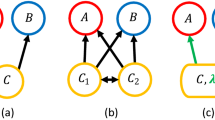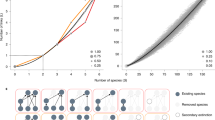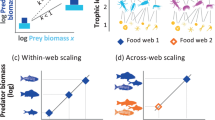Abstract
ECOLOGICAL food chains are typically short, consisting of not more than four or five trophic levels. This is usually explained by a reduction in the energy which is available to successive links in the food chain1,2. In contrast, we believe that the number of trophic levels is constrained by population dynamics and not by ecological energetics.
This is a preview of subscription content, access via your institution
Access options
Subscribe to this journal
Receive 51 print issues and online access
$199.00 per year
only $3.90 per issue
Buy this article
- Purchase on Springer Link
- Instant access to full article PDF
Prices may be subject to local taxes which are calculated during checkout
Similar content being viewed by others
References
Hutchinson, G. E. Am. Nat. 93, 145–159 (1959).
Slobodkin, L. B. Growth and Regulation of Animal Populations (Holt, Rinehart and Winston, New York, 1961).
Whittaker, R. H. Communities and Ecosystems (Collier Macmillan, London, 1975).
Mann, K. H. J. Anim. Ecol. 34, 253–275 (1965).
McNeill, S. & Lawton, J. H. Nature 225, 472–474 (1970).
Elton, C. S. Animal Ecology (Sidgwick and Jackson, London, 1927).
Strong, J. Antarctic Res. Ser. 10, 357–371 (1967).
Lamotte, M. in Tropical Ecological Systems (eds Golley, F. B. & Medina, E.) (Springer-Verlag, Berlin, 1975).
Goldman, B. & Talbot, F. H. in Biology and Geology of Coral Reefs. 3 (eds Jones, O. A. and Endean, R.) (Academic, New York, 1976).
Menge, B. A. & Sutherland, J. P. Am. Nat. 110, 351–369 (1976).
Janzen, D. in Evolutionary Strategies of Parasitic Insects and Mites (ed. Price, P. W.) (Plenum, New York, 1975).
Levins, R. in Towards a Theoretical Biology, Vol. 3. (ed. Waddington, C. H.) (Edinburgh University Press, 1970).
Levins, R. Evolution in Changing Environments (Princeton University Press, 1968).
Beddington, J. R., Free, C. A. & Lawton, J. H. J. Anim. Ecol. 45, 791–816 (1976).
May, R. M. Stability and Complexity in Model Ecosystems (Princeton University Press, 1973).
Maynard Smith, J. Models in Ecology (Cambridge University Press, 1974).
May, R. M. Nature 238, 413–414 (1972).
De Angelis, D. L. Ecology 56, 238–243 (1975).
Gilpin, M. E. Nature 254, 137–139 (1975).
May, R. M. Ecology 54, 638–641 (1973).
Gilpin, M. E. & Case, T. J. Nature, 261, 40–42 (1976).
Beddington, J. R. & Hammond, P. J. Anim. Ecol. (in the press).
Author information
Authors and Affiliations
Rights and permissions
About this article
Cite this article
PIMM, S., LAWTON, J. Number of trophic levels in ecological communities. Nature 268, 329–331 (1977). https://doi.org/10.1038/268329a0
Received:
Accepted:
Issue Date:
DOI: https://doi.org/10.1038/268329a0
This article is cited by
-
Fire return interval influences soil food web structure and stability in an oak-pine savanna
Plant and Soil (2024)
-
Community ecological response to polycyclic aromatic hydrocarbons in Baiyangdian Lake based on an ecological model
Ecotoxicology (2024)
-
Time delays modulate the stability of complex ecosystems
Nature Ecology & Evolution (2023)
-
Reactivity of complex communities can be more important than stability
Nature Communications (2023)
-
Algal blooms as a reactive dynamic response to seasonal perturbation in an experimental system
Theoretical Ecology (2023)
Comments
By submitting a comment you agree to abide by our Terms and Community Guidelines. If you find something abusive or that does not comply with our terms or guidelines please flag it as inappropriate.



